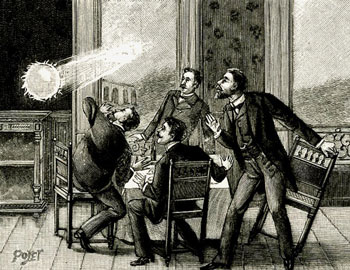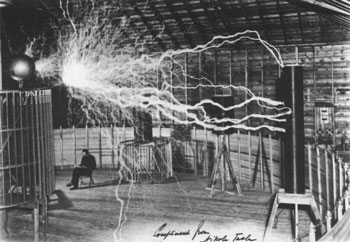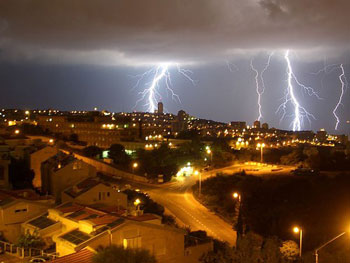Lightning

19th century illustration of diners being startled by ball lightning.
The phrase “struck by lightning” conjures images of complete devastation. Indeed, lightning, one of nature’s more powerful forces, has wreaked untold destruction throughout time.
The blasted stump of a once-tall tree stands as a symbol of lightning’s immense energy. When a bolt of lightning rips through a tree it can cut a wide, deep, tree-length rift, vaporizing sap and spraying it on the surrounding area.
But sometimes the full extent of damage does not become apparent for many years. Lightning once struck a tall pine on the author’s woodlot, but, amazingly, the tree lived for another five years. Then, as needles began turning brown and falling, other nearby white pine trees began showing symptoms of damage. These, along with the tree that was struck, all died.
The reason for this damage to surrounding trees was that the lightning not only traveled the length of the tree, it also followed its roots underground and that extended to the roots of nearby trees as well. Clearly, lightning has its dark side.
Varied Forms
A 3-foot, blue flame
in the general shape
of a Sawzall blade
shot out of the wall.
While everyone is familiar with the iconic, forked streak of lightning, lightning appears in other forms as well. Here’s another incident that occurred in the author’s lightning-prone house.
Once, as an approaching thunderstorm darkened the sky, the author sat at his kitchen table waiting for the storm to pass. And then something like the sound of mousetraps snapping inside the kitchen walls indicated that something out-of-the-ordinary was occurring. Arising from his chair and walking toward the wall to better hear the strange snapping noises, a 3-foot, blue flame in the general shape of a Sawzall blade shot out of the wall from the space between the kitchen cabinet and refrigerator.
This blue “blade” missed the author by inches, but caused no perceivable harm. After the storm had passed it was time to check the fridge and other appliances for damage, since it seemed that no electric device could withstand such a powerful energy surge. But surprisingly, neither the refrigerator nor the microwave nor the toaster oven, all plugged in at the time of the lightning strike, evidenced any sign of harm and all functioned perfectly thereafter.
The snapping in the walls was evidently a buildup to the dazzling-blue flame that shot out from the wall. The takeaway from this is that upon hearing clicking or snapping sounds coming from a wall or walls, it’s time to go to a safe place and take shelter.
Ball Lightning
People have witnessed and commented upon ball lightning since the time of the ancient Greeks. And yet, the phenomenon remains very much a mystery. Many people do not even believe in its existence. It was not until 1960 that scientific evidence supported its existence. But for those who have experienced ball lightning, it is very real and in most cases, terrifying.
A classic case of ball lightning comes from the author’s boyhood home in Belmont, Maine. One summer afternoon, after returning home from white-perch fishing, the author’s grandfather went to the basement to clean the fish, while the author and his grandmother sat upstairs and chatted.
The basement was equipped with a laundry sink, with a metal drainpipe that extended out from the basement and into a drainage ditch. This also served as a fish-cleaning station. While grandpa was rinsing his knife under the faucet, a ball of lightning blew out of the faucet, hitting him in the hand, traveling up his arm, through his body and down into the floor.
The force of the strike knocked Grandpa to the floor so violently that the knife flew out of his hand. Grandpa lay unconscious for some time and when he regained his senses, found he was paralyzed and could not speak to yell for help.
By this time the author and his grandmother wondered why Grandpa was taking so long to clean the fish, so they opened the basement door and found Grandpa on his belly, trying to crawl up the stairs, still unable to speak or cry for help.
Carrying Grandpa upstairs, he finally regained his power of speech and related the story of what happened. In time, the feeling returned to his body and he appeared none the worse for his ordeal.
Later, the author and his grandpa went down to the basement to care for the fish and to look for the knife. It was found approximately 30 feet from where Grandpa stood, a testimony to the power of ball lightning.

Nikola Tesla photographed reading in his lab by the light of lightning created by the generator behind him. A showman long before modern media, Tesla had held thousands of patents. His work influenced microwave technology, cell phones, X-rays and more.
But the house was not done with ball lightning yet. For years after, during thunderstorms, balls of white light would appear inside the house, seemingly from out of nowhere, floating and bobbing like disembodied spirits.
This same phenomena of white balls of light suddenly appearing inside during thunderstorms was a regular occurrence at another house eight miles away in Searsmont. No one was ever harmed because of the ball lightning, but every time it occurred it threw the occupants into much consternation. That same house had a history of ball lightning occurrences dating back over 100 years.
Here’s an account of one young boy’s experience with ball lightning that could have had unpleasant consequences if the boy were only a little bit taller. Two young brothers were inside their Waldo home during an electrical storm when suddenly, an orange-red ball of light a bit larger than a grapefruit came through a closed window and floated around the room.
The eldest boy tried to grasp the ball and ran after it, even jumping in his attempt to capture the floating orb. But he was not quite tall enough to reach it and the lightning ball finally exited the room the same way it came by passing through a window opposite from the one through which it entered.
Who can tell what might have happened had the boy been able to grab the lightning ball? We’ll never know, but the memory of the event lingers, even though this happened around 60 years ago.
In yet another instance, a Searsmont woman was struck by ball lightning. It happened this way: Hearing thunder approaching, the woman ran out to the pasture to lead her two horses back to the safety of the barn. As she was unhooking the gate on a barbed-wire fence, a ball of sizzling-white light ran down the fence wire and struck her, knocking her to the ground.
And like the author’s grandfather, the woman lay, paralyzed, for an indeterminate period of time. After she regained consciousness, the feeling slowly returned to her body and she was able to stand up, apparently unharmed. The event caused no lasting harm to the woman and the horses, as it turned out, were completely unscathed.
Auto Strike
The Browns smelled
something like rubber
burning. Then bedlam
reigned with the
automobile’s controls.
The idea that people in motor vehicles are safe from lightning strikes appears to have some merit. Just ask Dean and Terrie Brown of Swanville, Maine.
The Browns had just purchased a 2018 Toyota Camry, something Terrie had wanted for some time. Dean wasn’t sold on sedans, feeling that they were too low to the ground and hard to get in and out of. But since Terrie was to be the main driver, he acquiesced and soon after completing the purchase, the Browns drove to Monroe to visit with family and to pick up their grandson. On their way back to Swanville, they drove straight into a powerful thunderstorm.
Nearing a utility pole, Terrie reports seeing lightning strike the pole, after which it flowed down the pole to the ground and then up, under the car. According to Terrie, the steering wheel felt “funny.” And then she saw a blazing light shoot out from beneath the vehicle. Suddenly, the car stopped and the Browns smelled something like rubber burning. Then bedlam reigned with the automobile’s controls.
Dean said the control panel went “haywire, with bells buzzing and lights flashing.” So they turned off the vehicle and called for help. Fire and police emergency services arrived and seeing no fire, unhooked the vehicle’s battery. Despite all this, the vehicle appeared to have suffered no damage. Even the tires, the probable source of the smell of burning rubber, seemed in good shape. The car was then towed to the Toyota dealer. The dealer called the factory and explained the situation. The factory representative said, “Forget it. The car is ruined.”
The insurance company paid only some of the bill, leaving the Browns $5,000 in the hole.
Later, the Browns bought another new vehicle, this time a Rav 4. Dean later added, “Well, Terrie always wanted a Camry and she had one, at least for a little while.” He then joked that friends all told him that after the lightning incident, he should have gone out and purchased a lottery ticket.
So does the Browns’ experience with lightning indicate that anyone in a motor vehicle is safe from a lightning strike? By no means. Every case is different and the danger from lightning is not necessarily diminished by being inside a motor vehicle.
Scientific Research
An article (with no author named) about ball lightning in Scientific American in the late 1990s stated that, “The scientific community is convinced that ball lightning is a real phenomenon (although there remain some skeptics). What could cause ball lightning, on the other hand, is a source of steady controversy.”
That same article contained the following: “Ball lightning is typically described as a luminous ball one to 25 centimeters (9 3/4 inches) in diameter having about the intensity of a 20-watt incandescent lamp; the phenomenon usually occurs after a lightning strike. It almost always moves, has a top speed of about three meters per second and floats about one meter above the ground. The motion can be counter to the prevailing breeze and can change direction erratically. Ball lightning may last up to 10 seconds, whereupon the ball extinguishes either noiselessly or with a bang. There have been many observations of ball lightning inside of houses and even in airplanes. There have also been a number of observations of ball lightning passing through closed windows, with no apparent damage to the glass. Usually there is no discernible heat production, although a recent observation reported a wooden plank that was singed. Several people have reported the smell of ozone and nitrogen associated with ball lightning and also static in a transistor radio.”
While the above quote suggests that ball lightning isn’t very bright, reports given to the author, along with his own experience, indicates otherwise. Also, historical records tell of ball lightning exploding and injuring and even killing bystanders. One such story from 1753, this one courtesy of Wikipedia, recounts the fatal encounter of Georg Richmann, a Russian university professor, who attempted to emulate Benjamin Franklin’s kite-flying experiment of one year earlier.
Richmann had devised a kite-borne device much like Franklin’s. One day Richmann heard thunder, dug out his kite apparatus and flew it. But unlike what happened with Ben Franklin, ball lightning suddenly materialized and traveled down the kite string, striking Richmann in the forehead, killing him.
Richmann’s body was left with a red spot on the forehead, singed clothes and his shoes blown open. The lightning also split the door frame of Richmann’s house and tore the door from its hinges.
Chain Lightning

Chain lightning, apparently much less common than ball lightning, seems even more mysterious and even downright spooky. All Wikipedia has to say about it is, “Chain lightning may refer to angular, zigzag, or forked lightning.
So perhaps the blue, saw blade-shaped flame that shot out from the wall in the author’s house was in fact, chain lightning. It also seems possible that the lightning that destroyed the electronics in Dean and Terrie Brown’s Toyota was a form of chain lightning.
Chain lightning strikes so infrequently that little is known about it.
Manmade Lightning
An article by Samuel Cohen in the online publication, Tesla Universe, tells of how Dr. Nikola Tesla created lightning by means of his innovative Tesla Coil. Tesla was at the threshold of devising a means of sending electricity through the air, circumventing the need for wiring. Tesla’s hope was to create cheap electricity that could power the world at very little cost.
His device, which was set up in his laboratory, was capable of discharging not only innumerable, long sparks, but also something like a lightning bolt that measured 65 feet from end-to-end.
Tesla was in competition with Thomas Edison at the time and it was Edison, rather than Tesla, who won critical acclaim and was rewarded with accolades and plenty of funding. Tesla, on the other hand, lost his funding and was compelled to shut down his laboratory. Had things gone the other way, the name Nikola Tesla might be upon everyone’s tongue today.
Referred to by some as “the man who invented the modern world”, Tesla invented microwaves, alternating current, the laser, florescent bulbs, x-rays, radio, remote control, the electric motor, robotics and wireless communications. Had the Tesla Coil, based on the concept that the Earth itself is a magnet that can generate electricity (electromagnetism), been developed the world might have had the opportunity enjoy essentially cost and pollution free electricity.
Despite this, Tesla did something no one else had done. He created lightning.
So the next time distant thunder reaches your ears, think back to the events given in this story and always, remember the old admonition that if you can hear thunder, you are close enough to be struck by lightning.
